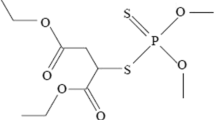Abstract
Background and Aims
Bromoacetic adds are a by-product of water ozonation and dibromoacetic acid (DBAA) in particular, which is a by-product of disinfection, inhibits male reproductive functions. In order to understand its effects, the spermatozoa and testes of mice were exposed to DBAA.
Methods
Twelve-week-old ICR mice were exposed to 10 p.p.m. DBAA. They were examined in regards to effects on the weights of body, testis and epididymis, the histological changes of tesits and the protein expression in testis.
Results
Neither the bodyweight nor the weights of the testis and epididymis of the exposed mice was affected, but approximately 13% of spermatozoa obtained from the cauda epididymis were motile with a drop-shaped head, and structures resembling residual bodies were found in the testis. Moreover, the expression of two testis proteins was changed by exposure to DBAA.
Conclusions
It was likely that DBAA inhibited male reproductive functions by disturbance of spermatogenesis via change of protein expression.
Similar content being viewed by others
References
De Kretser DM, Kerr JB. The cytology of the testis. In: Knobil E, Neill JD eds. The Physiology of Reproduction, 2nd edn, Vol. 1. New York: Raven Press, 1994; 1177–1290.
Bardin CW, Cheng CY, Mustow NA, Gunsalus GL. The Sertoli cell. In: Knobil E, Neill JD eds. The Physiology of Reproduction, 2nd edn, Vol. 1. New York: Raven Press, 1994; 1291–1333.
Rossi P, Albanesi C, Grimaldi P, Geremia R. Expression of the mRNA for the ligand of c-kit in mouse Sertoli cells. Biochem Biophys Res Commun 1991; 176: 910–914.
Tajima Y, Onoue H, Kitamura Y, Nishimune Y. Biological active kit ligand growth factor is produced by mouse Sertoli cells and is defective in SId mutant mouse. Development 1991; 113: 1031–1035.
Yoshinaga K, Nishikawa S, Ogawa M et al. Role of c-kit in mouse spermatogenesis: identification of spermatogonia as a specific site of c-kit expression and function. Development 1991; 113: 689–699.
Albanesi C, Geremia R, Giorgio M, Dolci S, Sette C, Rossi P. A cell- and developmental stage-specific promoter drives the expression of a truncated c-kit protein during mouse spermaticd elongation. Development 1996; 122: 1291–1302.
Eddy B, O’Brien DA. The spermatozoon. In: Knobil E, Neill JD eds. The Physiology of Reproduction, 2nd edn, Vol. 1. New York: Raven Press, 1994; 29–77.
Glaze WH, Weinberg HS, Cavanagh JE. Evaluating the formation of brominated DBFs during ozonation. J Am Water Works Assoc 1993; 85: 82–87.
Linder RE, Klinefelter GR, Strader LF, Suarez JD, Roberts NL, Dyer CJ. Spermatotoxicity of dibromoacetic acid in rats after 14 daily exposures. Reprod Toxicol 1994; 8: 251–259.
Linder RE, Klinefeiter GR, Strader LF, Suarez JD, Dyer CJ. Acute spermatogenic effects of bromoacetic acids. Fundam Appl Toxicol 1994; 22: 422–430.
Linder RE, Klinefelter GR, Strader LF et al. Dibromoacetic acid affects reproductive competence and sperm quality in the male rat. Fundam Appl Toxicol 1995; 28: 9–17.
Linder RE, Klinefelter GR, Strader LF, Veeramachaneni DNR, Roberts NL, Suarez JD. Histopathologic changes in the testes of rats exposed to dibromoacetic acid. Reprod Toxicol 1997; 11: 47–56.
Vetter CM, Miller JE, Crawford LM et al. Comparison of motility and membrane integrity to assess rat sperm viability. Reprod Toxicol 1998; 12: 105–114.
Fujinoki M, Ohtake H, Okuno M. Serine phosphorylation of flagellar proteins associated with the motility activation of hamster spermatozoa. Biomed Res 2001; 22: 45–58.
Maleszewski M, Kline D, Yanagimachi R. Activation of hamster zona-free oocytes by homologous and heterologous spermatozoa. J Reprod Fertil 1995; 105: 99–107.
Hirano H, Kawasaki H, Sassa H. Two-dimensional gel electrophoresis using immobilized pH gradient tube gels. Electrophoresis 2000; 21: 440–445.
Laemmli UK. Cleavage of structural proteins during assembly of the head of bacteriophage T4. Nature 1970; 227: 680–685.
Si Y, Okuno M. Multiple activation of mouse sperm motility. Mol Reprod Dev 1993; 36: 89–95.
Morisawa M. Cell signaling mechanisms for sperm motility. Zool Sci 1994; 11: 647–662.
Yanagimachi R. Mammalian fertilization. In: Knobil E, Neill JD eds. The Physiology of Reproduction, 2nd edn. Vol. 1. New York: Raven Press, 1994; 189–317.
Shivaji S, Peedicayil J, Girija Devi L. Analysis of the motility parameters of in vitro hyperactivated hamster spermatozoa. Mol Reprod Dev 1995; 42: 233–247.
Yanagimachi R. In vitro capacitation of hamster spermatozoa by follicular fluid. J Reprod Fertil 1969; 18: 275–286.
Yanagimachi R. The movement of golden hamster spermatozoa before and after capacitation. J Reprod Fertil 1970; 23: 193–196.
Author information
Authors and Affiliations
Corresponding author
About this article
Cite this article
Fujinoki, M., Imaizumi, Y., Ohtake, H. et al. Effects of dibromoacetic add on murine spermatozoa and testis. Reprod Med Biol 3, 85–93 (2004). https://doi.org/10.1111/j.1447-0578.2004.00059.x
Received:
Accepted:
Issue Date:
DOI: https://doi.org/10.1111/j.1447-0578.2004.00059.x




